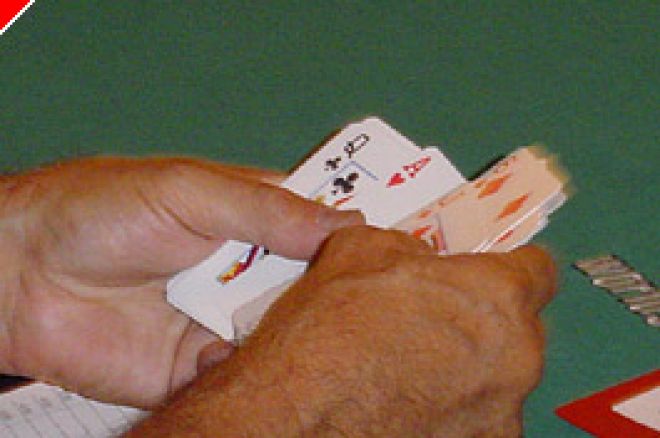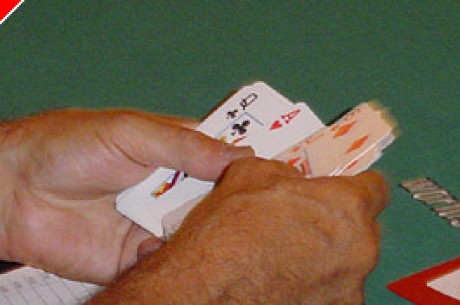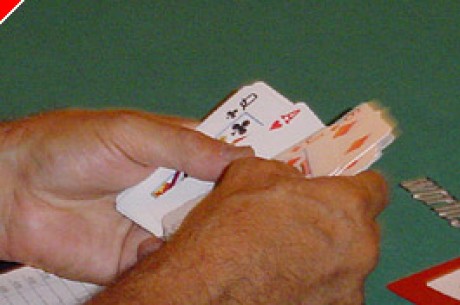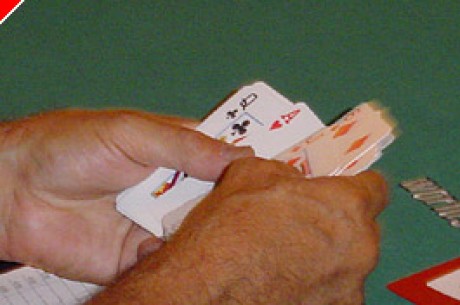Stud Poker Strategy: Stud/8 Sit N Goes, Part Two

With your high hands without lows you will be extremely cautious, only entering the hand when you are certain or nearly certain that you have the highest, and then entering for a raise �C to knock out other hands that might be tempted to draw otherwise. And you will fold these hands on Fourth if it looks like your opponent may have hit either a higher high hand and on Fifth if it looks like your opponent made his low and you have still not improved.
You will play cautiously against players once they seem to have made a low �C often folding your pair on Third and Fourth if there's no low draw to go with it �C when you're against hands that all look to be either low hands or high hands that might be better than yours.
Ideally, what you'd like to do is play against lower high hands or one low hand that doesn't have an Ace.
Here's an example of that:
You have (KK)7c. You play Third Street for a raise from a player with (xx)3. Two low cards after you and the initial low hand call to see Fourth Street. On Fourth you get a babe. The 3 gets an Ace, one of the other low cards pairs up and the last low hand gets another low card. You see this on Fourth Street.
(KK)76
(xx) 3A
(xx)44
(xx)82
The 44 bets. The 8s calls. Fold here. Sure, the open pair of 4s probably doesn't have trips �C since he was more likely to play three low cards on Third than a pair of 4s in this high low game. In a live Stud8 game you might even raise. But so what? In a tourney, with a limited stack, you can't risk this bet with the likelihood that even if you win you'll probably be splitting the pot it. You have no low and you might be against trips, two pair or now a pair of Aces. Even if you're still in the lead with your high hand, it's only a high hand with no chance to win low. That's too thin to draw to �C especially when you might be woefully behind if Aces or trips are out there when you're closer to a .15 Expected Value (EV). Fold this hand.
Here are some other hands to fold.
You have (kk)5. You raise on third and someone with an Ace re-raises. Fold. You raised on Third; another card called and then got an Ace on Fourth and bet. Fold. You have (QQ)2 and get raised by a King. Fold that too.
There are hands that you'll be tempted to raise with that you should either call or fold. They usually involve a small pair and a babe. (76)6. Early in the tourney this is a folding hand. So too is (22)K or (88)9 �C even if they are two-suited. You just have too long to go to know that you have a lock on one way of the hand for the draw to be worth it. These don't constitute legitimate hands early in a sit and go tourney.
On the other hand, a pair of Aces and a babe is an ideal raising hand. Others will put you on a low and might well call, incorrectly, with high pairs. That's ideal. For example, if you have (AA)2 or (A2)A and raise the bring in, it looks like you're playing a low aggressively. (KK)7 or even (K7)K might call or even raise you (I said there were bad players at this level). Let him raise. It will probably get the pot heads up �C since his raise or even your raise will knock out bad low draws. Don't repop him. Just call along �C as if you really do have a low draw and don't relish the prospect of playing heads up with just a low hand.
You must be careful if you find that you're probably being free-rolled by a player who has already made a low. If, for example, you started out with a pair of Kings, and your opponent progresses from (xx)3s to (xx)3s4s to (xx)3s4s6s, you must check and fold if he bets (which he should do even as a bluff). Similarly if you started with the same hand and your opponent progresses from (xx)6d to (xx)6d5c to (xx)6d5cAd you should fold to a bet (unless of course the pot is huge because of many players being in until then). But since you're only going for half the pot and your opponent is likely to have at least half the pot sewn up, you have only a small amount of potential money you're chasing. Get out now.
How different if you started with (As2s)Ad. That might progress to (As2s)Ad7s6c. You still only have the Aces, but you have a scary board and a low draw. This hand you must continue to bet aggressively.
Just one final word of caution. More money is probably lost on hands that start out as high hands and don't improve, against a player who is on a low and then free rolls with a made low, than with any other starting hand. That's why you have to be so cautious against lows with high draws. Fold on Fourth if your opponent bets an exposed Ace and you have a high pair. Fold on Fifth if your opponent hits three babes or an Ace and bets into your unimproved high pair. No reason to draw to it �C it's a long term loser.
Ed Note: You'll be a long term winner if you play at Pacific Poker








